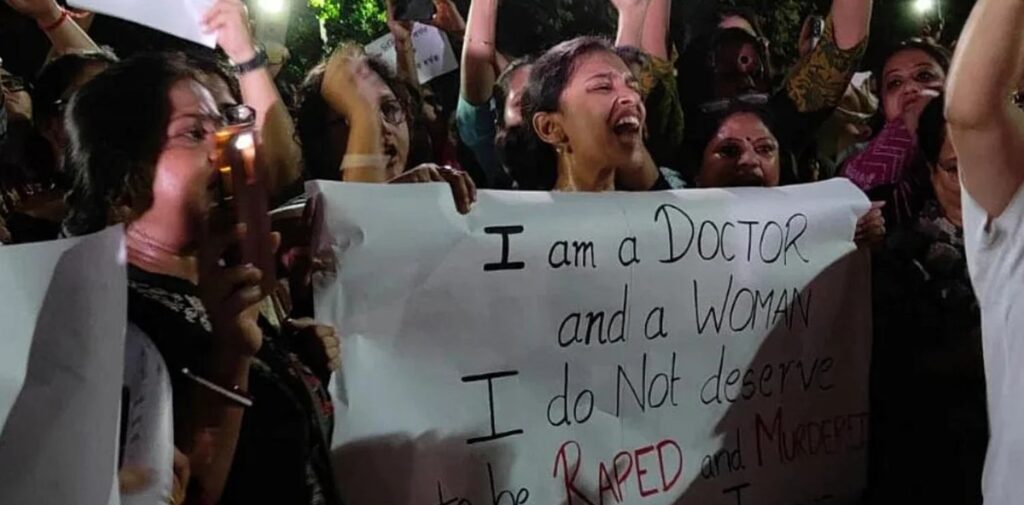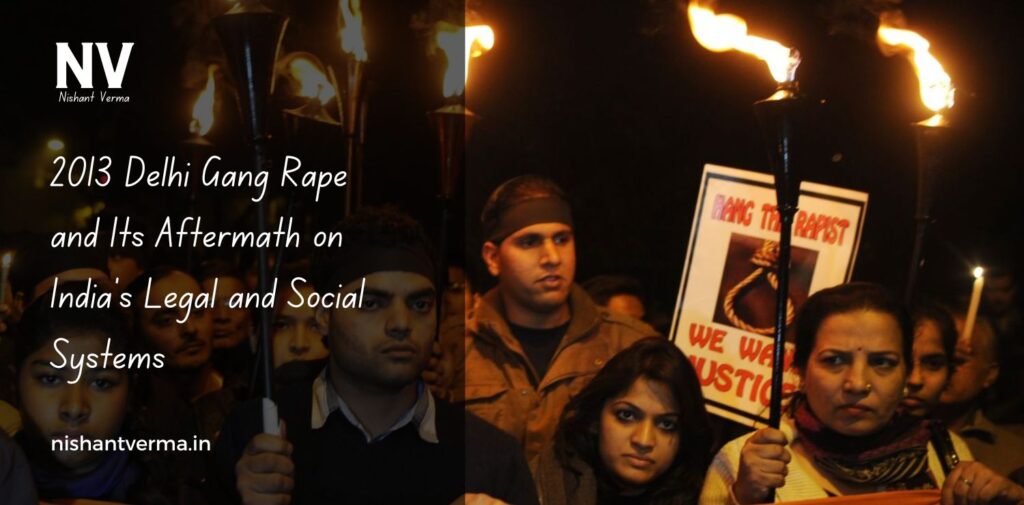The 2013 Delhi gang rape, also known as the Nirbhaya case, shocked the nation and brought India’s issues related to women’s safety to the forefront. The horrific incident, which took place on December 16, 2012, involved the brutal assault and gang rape of a young woman in a moving bus in Delhi. The victim, later named Nirbhaya, died from her injuries two weeks after the attack, sparking massive protests and widespread outrage across the country. This tragic event became a turning point in India’s approach to women’s safety and had profound impacts on both the legal and social systems. The following article examines the aftermath of the 2013 Delhi gang rape and its lasting effects on Indian society.
The Incident That Shook a Nation
On the evening of December 16, 2012, a 23-year-old physiotherapy intern, Nirbhaya, boarded a private bus with a male companion after a movie. Unbeknownst to them, the bus was driven by a group of men who had planned a horrific assault. The men, including the bus driver, brutally raped and assaulted Nirbhaya, while also attacking her companion. The gruesome nature of the assault shocked the nation, and the victim’s eventual death from her injuries sparked massive protests. People across India, especially in Delhi, took to the streets demanding justice for Nirbhaya, with a united cry for better protection of women.
The Delhi gang rape case led to nationwide anger, highlighting the serious issues of sexual violence and the lack of safety for women in India’s cities. The public outrage eventually led to policy changes and legal reforms, aimed at protecting women and ensuring stricter punishment for those involved in such heinous crimes.

The Protests and Public Outcry
Following the gang rape, there was an unprecedented wave of protests throughout India, especially in Delhi, where thousands of people, particularly women, gathered to demand justice. The protests were driven by a deep sense of frustration over the increasing incidents of sexual violence and the lack of effective action by authorities. The anger was directed not only at the criminals who committed the rape but also at the failures in the justice system, police indifference, and society’s treatment of women.
The protesters, mainly young people, also called for better safety measures for women, stricter laws, and a more empathetic approach to addressing crimes against women. The protests gained widespread media attention and brought the issue of women’s safety into the public conversation like never before. It became evident that the problem of sexual violence was systemic and deeply ingrained in Indian society, and that significant reform was needed.
Legal Reforms Post-Nirbhaya Case
The outrage sparked by the Delhi gang rape led to several significant legal reforms aimed at improving the safety of women in India. The Justice Verma Committee, established by the government to recommend changes to the law, played a crucial role in these reforms. The committee, headed by former Supreme Court judge Justice J.S. Verma, submitted its report in January 2013, recommending comprehensive changes to existing laws related to sexual violence.
One of the key recommendations was the amendment of the Indian Penal Code (IPC) to introduce stricter punishments for crimes like gang rape, acid attacks, and sexual harassment. The committee proposed a broader definition of rape to include various forms of sexual assault, as well as the introduction of the death penalty for rapists in cases where the victim dies or is left in a vegetative state. The Criminal Law (Amendment) Act, 2013, was passed by the government in response to these recommendations, leading to stricter laws and harsher punishments for offenders.
In addition to changes to rape laws, the amendment also focused on ensuring faster trial processes and a more sensitive approach to handling sexual assault cases. The establishment of fast-track courts for such cases aimed to expedite the judicial process and reduce delays in delivering justice.
Another important reform was the introduction of the anti-stalking law, which made stalking a criminal offense. The new laws were designed to address the growing concerns over women’s safety and improve the mechanisms for reporting crimes against women.

The Role of Police and Law Enforcement
The police’s response to the Nirbhaya case was widely criticized. Initially, the victim’s family faced difficulty in getting the case registered, and there were accusations of negligence and insensitivity from law enforcement. The lack of timely action and the slow response of the police highlighted the broader issues within India’s law enforcement system, including the underreporting of crimes against women and a general reluctance to take such cases seriously.
In response to these criticisms, there were calls for reforms within the police force to make them more responsive and sensitive to the needs of women. Several measures were introduced to improve the police force’s approach to crimes against women. These included the establishment of Women’s Police Stations across major cities, the training of officers on how to handle cases of sexual assault, and the creation of helplines for women in distress.
However, despite these measures, the effectiveness of police reforms has been questioned in the years following the Nirbhaya case. The slow response in many cases of sexual violence and the ongoing challenges in securing convictions highlight the deep-rooted problems in law enforcement.
Social Attitudes and Cultural Change
While legal reforms have been a significant part of the aftermath of the 2013 Delhi gang rape, there has also been a broader cultural shift in how India views women’s rights and gender equality. The Nirbhaya case forced the country to confront uncomfortable truths about its attitudes toward women. Deeply ingrained gender biases, often reflected in everyday attitudes and behaviors, came under scrutiny. The case highlighted the need for a cultural transformation where women are not treated as second-class citizens.
One of the key aspects of this cultural shift has been the growing acceptance of the need to empower women through education, employment, and social equality. More women in India are demanding their right to live free from violence, harassment, and discrimination. The Nirbhaya case catalyzed discussions about women’s roles in society and the need for greater participation in the public sphere.
At the same time, India has seen a rise in the Me Too movement, where women have come forward to speak about their own experiences of sexual harassment and assault. This has led to greater awareness of the pervasive nature of sexual violence and the need for collective action to address it.
However, despite these advancements, the road to cultural change is still long. Social attitudes about women’s autonomy, respect, and rights continue to be influenced by traditional norms in many parts of the country, particularly in rural areas.

The Continued Struggle for Women’s Safety
While significant strides have been made since the 2013 Delhi gang rape, women in India still face serious challenges in terms of safety and equality. Sexual violence remains a widespread problem, and many women continue to live in fear of harassment, assault, and discrimination. High-profile cases of sexual violence, such as the Hyderabad rape case in 2019, show that despite legal reforms, the implementation of justice and the protection of women remains an ongoing struggle.
Public awareness and activism continue to play a key role in pushing for further reforms and greater accountability from authorities. Citizens, NGOs, and women’s rights organizations continue to advocate for better safety measures, including improved street lighting, better public transport systems, and the creation of safe spaces for women.
The continued media coverage of cases like Nirbhaya’s also keeps the issue of women’s safety in the national conversation, putting pressure on policymakers and law enforcement agencies to act more decisively. The Nirbhaya case remains a symbol of the need for social and legal change, and its impact on the country’s legal and social systems cannot be overstated.
Conclusion: 2013 Delhi Gang Rape
The 2013 Delhi gang rape and its aftermath have had a profound impact on India’s legal and social systems. The case led to significant legal reforms, improved police responses, and a cultural shift in attitudes toward women’s rights and safety. However, the struggle for women’s equality and safety is far from over. While there have been improvements in the legal framework and greater public awareness, many challenges remain.
To create a society where women are truly safe and respected, India must continue its efforts to reform both its legal systems and its social norms, ensuring that justice for victims of violence is swift and that women’s rights are protected in every aspect of life. The memory of Nirbhaya continues to drive these reforms, serving as a reminder of the work that still needs to be done




